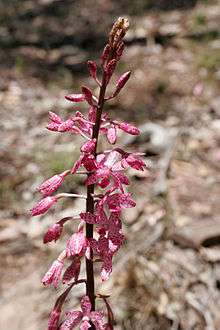Dipodium
| Dipodium | |
|---|---|
 | |
| Dipodium punctatum | |
| Scientific classification | |
| Kingdom: | Plantae |
| (unranked): | Angiosperms |
| (unranked): | Monocots |
| Order: | Asparagales |
| Family: | Orchidaceae |
| Subfamily: | Epidendroideae |
| Tribe: | Cymbidieae |
| Subtribe: | Cymbidiinae[1] |
| Alliance: | Dipodium |
| Genus: | Dipodium R.Br.[2] |
| Type species | |
| Dipodium punctatum[2] | |
| Species | |
|
see text | |
| Synonyms | |
| |
Dipodium is a genus of about 25[3] species of orchids native to tropical, subtropical and temperate regions of south-east Asia, New Guinea, the Pacific Islands and Australia. It is the only genus of its alliance, Dipodium. Plants of this genus are commonly referred to as hyacinth orchids.[2]
Description
The species are perennial terrestrial herbs or herbaceous climbers/epiphytes.[4][5] Many species, particularly in eastern Australia are leafless mycoheterotrophs. Others have medium-sized to very large leaves that are parallel-veined and with entire margins.[4]
Flowers are arranged in a raceme with very few or up to 50 flowers.[4] These may be fragrant or odourless, are white, pink, purple, yellow or green, often with spots or blotches.[4] The labellum is three-lobed.[4] Each of the flowers have two pollinia that are supported on two stipes.[4] Dehiscent capsules, produced after flowering, hold the seed which is released when they split longitudinally along six seams.[4] Between 30 and 500 seeds are produced per capsule.[4]
Taxonomy
The genus was formally described in 1810 by Scottish botanist Robert Brown in Prodromus Florae Novae Hollandiae et Insulae Van Diemen.[2] The name Dipodium is derived the Greek words di (two) and podia (little feet), a reference to the two stipes supporting the pollinia.[3]

Species
Species include:[6]
- Dipodium atropurpureum - from New South Wales
- Dipodium bicallosum - from Peninsular Malaysia and Sumatra
- Dipodium bicarinatum - from Peninsular Malaysia
- Dipodium brevilabium - from Western Papua
- Dipodium campanulatum - bell-flower hyacinth-orchid, from South Australia and Victoria
- Dipodium conduplicatum - from Peninsular Malaysia and Sumatra
- Dipodium elegans - from Sumatra
- Dipodium elegantulum - elegant hyacinth-orchid, from Queensland
- Dipodium ensifolium - leafy hyacinth-orchid, from north-east Queensland
- Dipodium fevrellii - from Sulawesi
- Dipodium fragrans - from Sumatra, Peninsular Malaysia, Borneo and Sulawesi
- Dipodium freycinetioides - from Palau
- Dipodium gracile - from Sulawesi
- Dipodium hamiltonianum - yellow hyacinth-orchid, from Queensland, New South Wales and Victoria
- Dipodium paludosum - from Cambodia, Thailand, Vietnam, The Philippines, Sumatra, Peninsular Malaysia and Borneo
- Dipodium pardalinum - spotted hyacinth-orchid or leopard hyacinth-orchid, from South Australia and Victoria
- Dipodium parviflorum - from Peninsular Malaysia and Sumatra
- Dipodium pictum - from Malesia and the Cape York Peninsula in Queensland
- Dipodium pulchellum - from New South Wales and Queensland
- Dipodium punctatum - blotched hyacinth-orchid or hyacinth orchid, from New South Wales, Victoria, and South Australia
- Dipodium purpureum - from Borneo
- Dipodium roseum - rosy hyacinth-orchid or pink hyacinth-orchid, from New South Wales, Victoria, South Australia and Tasmania
- Dipodium scandens - from Borneo, Java, The Philippines, Sulawesi, New Guinea, the Bismark Archipelago and the Solomon Islands
- Dipodium speciosum - from Peninsular Malaysia
- Dipodium squamatum - from New Caledonia and Vanuatu
- Dipodium stenocheilum - tropical hyacinth-orchid, from the northern parts of Western Australia, the Northern Territory and Queensland.
- Dipodium variegatum - blotched hyacinth-orchid or slender hyacinth-orchid, from Queensland, New South Wales and Victoria
Undescribed species
- Dipodium sp. Basalt Woodland (M.D. Barrett 198) - northern Kimberley, Western Australia.[7]
- Dipodium sp. Sandstone (R.L. Barrett & K.W. Dixon 1642) - northern Kimberley,[8]
Ecology
It is thought that the flowers attract native bees and wasps through floral mimicry.[9]
Uses
An infusion of the leaves of Dipodium pandanum is traditionally drunk in Bouganville to help relieve respiratory infections.[10]
Cultural references
A hyacinth orchid is the subject of the poem The Aboriginal Axe by Australian poet Douglas Stewart. In the poem, Stewart refers to the flowers as "lovely and leprous, flushed and spotted".[11]
External links
References
- ↑ "Dipodium R.Br.". The Orders and Families of Monocots. eMonocot. Retrieved 18 April 2014.
- 1 2 3 4 "Dipodium R.Br". Australian Plant Name Index (APNI), IBIS database. Centre for Plant Biodiversity Research, Australian Government. Retrieved 7 February 2014.
- 1 2 Clements, Mark A (2013). The Allure of Orchids. National Library Australia. pp. 48–51. ISBN 978-0-642-27807-4.
- 1 2 3 4 5 6 7 8 "Dipodium R.Br.". FloraBase. Western Australian Government Department of Parks and Wildlife.
- ↑ Weston, P.H. "Genus Dipodium". PlantNET - New South Wales Flora Online. Royal Botanic Gardens & Domain Trust, Sydney Australia. Retrieved 7 February 2014.
- ↑ "Dipodium". The Plant List version 1.1. Retrieved 29 January 2013.
- ↑ "Dipodium sp. Basalt Woodland (M.D. Barrett 198)". FloraBase. Western Australian Government Department of Parks and Wildlife.
- ↑ "Dipodium sp. Sandstone (R.L. Barrett & K.W. Dixon 1642)". FloraBase. Western Australian Government Department of Parks and Wildlife.
- ↑ Jessup, Scott; Johnson, Glen (1997). "Yellow Hyacinth Orchid Dipodium hamilonianum Action Statement" (PDF). Department of Sustainability andEnvironment. Retrieved 7 February 2014.
- ↑ Lawler, L.J.; Slaytor, M. (1969). "The distribution of alkaloids in orchids from the territory of Papua and New Guinea". Proceedings of the Linnaen Society of New South Wales. 94: 237. Retrieved 8 February 2014.
- ↑ Stewart, Douglas. "The Aboriginal Axe". Australian Poetry Library.